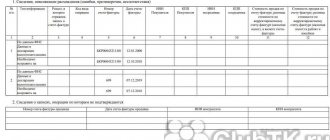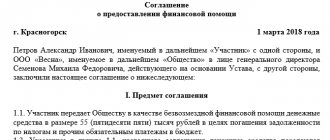Why do you need an explanatory note to the financial statements?
Drawing up annual financial statements, including for small and medium-sized businesses, is a mandatory procedure. The only exceptions are budgetary and public organizations that are not engaged in entrepreneurial activities. Reporting documents do not always make it possible to fully illuminate the financial situation of an enterprise; this is precisely why an explanatory note is drawn up. It is called explanatory because it explains other reporting documents. It only supplements the data from the main accounting reports.
The explanatory note to the organization's financial statements describes all the key events that occurred over a specified period of time with a description of the financial position at the end of the year.
You need to draw up an explanatory note carefully, since if the information from the report does not correspond to reality, problems may arise.
How to do a balance reformation
Balance sheet reformation is the write-off of profit (loss) received by the company over the past financial year.
The reformation is carried out on December 31, after the last fact of the company’s economic life is reflected in the accounting.
The balance sheet reform operation consists of two stages:
- close the accounts in which the company's income and expenses were recorded during the year. These are accounts 90 “Sales” and 91 “Other income and expenses”;
- include the financial result obtained by the company over the past year as part of retained earnings or uncovered losses.
How to correctly write an explanatory note to financial statements?
There are no clear rules according to which it is necessary to draw up an explanatory note. Each enterprise independently determines the volume and form of presentation of information. Since the main purpose of the explanatory note is not the correctness of the structure, but the most understandable detail of the accounting statements. A document can contain not only text, but also graphs, tables, charts, diagrams, etc.
The explanatory note to the annual financial statements must give a true and in-depth idea of the financial position of the organization and the results of its activities. It should include information:
- About the enterprise (its structure and areas of activity);
- About changes in accounting policies. Here it is necessary to indicate the reason for the changes and describe the possible consequences;
- About the factors influencing the results of the enterprise's activities. Factors that did not have a strong impact on overall financial performance should not be included in the explanatory note.
Since the note is drawn up in any form, to describe the financial condition of the enterprise, you can indicate both general information and a detailed explanation of individual financial indicators.
Also, as part of information about related parties, information is disclosed on the amount of remuneration paid by the organization to key management personnel.
According to clause 11 of PBU 11/2008, for the purposes of these Regulations, the main management personnel of the organization are understood as managers (general director, other persons exercising the powers of the sole executive body of the organization), their deputies, members of the collegial executive body, members of the board of directors (supervisory board) or another collegial management body of the organization, as well as other officials vested with powers and responsibilities in matters of planning, management and control over the activities of the organization.
Events after the reporting date. According to PBU 7/98 “Events after the reporting date”, an event after the reporting date is recognized as a fact of economic activity that has had or may have an impact on the financial condition, cash flow or results of operations of the organization and which occurred in the period between the reporting date and the date of signing the accounting reporting for the reporting year.
An approximate list of events after the reporting date can be found in PBU 7/98, the list is quite large.
Provisions, contingent liabilities and contingent assets.
PBU 8/2010 “Estimated liabilities, contingent liabilities and contingent assets” introduces three concepts, information about which must be disclosed in financial statements:
— estimated liabilities (liabilities already existing at the reporting date);
— contingent liabilities (possible liabilities);
— contingent assets.
EXAMPLES of information disclosure in an explanatory note:
1. The company is a defendant in a number of arbitration processes that arose in the course of conducting financial and economic activities. However, in the opinion of the Company's management, the results of these processes will not have a significant impact on the financial position of the Company.
The total amount of claims against the Company is 6,200 thousand rubles. From this amount:
— a lawsuit based on a claim by the Ministry of Property Relations of the Altai Republic for the recovery of property from someone else’s illegal possession. The price of the claim is 1,200 thousand rubles.
— litigation on the claim of Sibir-Agro LLC against the Company for the collection of sanctions for late payment in the amount of 5,000 thousand rubles. according to decision No. 01-72/13 of 06/21/2017.
There are no other legal proceedings involving the Company that can be classified as significant as of December 31, 2017.
2. In November 2021, an on-site tax audit began. As of the date of preparation of financial statements for 2021, the audit has not been completed and the Federal Tax Service's report has not been submitted. It is not possible to assess the results of the audit and the possible impact of this conditional fact of economic activity, if any, at the reporting date.
The Company's management believes that tax liabilities are fully reflected in the attached balance sheet. However, the risk remains that the tax authorities will take a fundamentally different position in relation to issues that are subject to the possibility of ambiguous interpretation, which may have a significant effect on the financial position of the Company.
3. As of the reporting date, the organization created a reserve for payment of vacations, the amount of which, taking into account insurance premiums, amounted to 3,568 thousand rubles.
State assistance and free receipt. The requirements for the formation of this section are regulated by PBU 13/2000 “Accounting for State Aid” and PBU 9/99 “Income of the Organization.”
In accordance with paragraph 22 of PBU 13/2000, at least the following information regarding state aid is subject to disclosure in this section:
1. the nature and amount of budget funds recognized in accounting in the reporting year;
2. purpose and amount of budget loans;
3. the nature of other forms of government assistance from which the organization directly receives economic benefits;
4. conditions for the provision of budgetary funds that were not fulfilled as of the reporting date and the associated contingent liabilities and contingent assets.
In the same section, an organization may disclose information related to the gratuitous receipt of assets.
Despite the fact that Form No. 5 reflects the amount of state aid, the explanatory note must reflect the nature of the financing.
EXAMPLE of explanatory note text:
State assistance for the sale of milk in 2021 amounted to 15,000 thousand rubles. (at the rate of 1 rub./l), maintenance of breeding livestock - 10,000 thousand rubles. (60% of maintenance costs), acquisition of fixed assets – 6,000 thousand rubles. (according to the reimbursement program 30% of the cost).
Information on discontinued activities. According to paragraph 11 of PBU 16/02 “Information on discontinued activities,” the organization must indicate in the explanatory note:
— the operating or geographic segment within which the discontinuation of activities occurs;
— the date of recognition of the activity as discontinued and the period in which the termination of the organization’s activities is expected to be completed.
In addition, the explanatory note must reflect the value of the organization's assets and liabilities that are expected to be disposed of or paid off as part of the termination of operations, as well as the amount of income, expenses, profits or losses before tax. In this case, information must be provided separately for each type of discontinued activity.
The organization is required to disclose information on discontinued activities, starting from the reporting year in which the activity is recognized as discontinued, until the reporting period (inclusive) when the program for discontinuing activities is actually completed (although settlements for it may not be completed) or the organization abandoned it. If the termination program is cancelled, this fact must be reflected in the explanatory note.
Such information is provided only by those organizations that have several types of activities or conduct them in several regions and intend to cease some of their activities. If the organization’s activities do not have such features, then the explanatory note will not contain special sections dedicated to the disclosure of this information.
For example, if an organization plans to stop livestock farming activities and engage only in crop production, information about this should be reflected in the explanatory note section.
Analysis and assessment of the balance sheet structure and profit dynamics. The financial statements should assess the financial condition of the organization for the short and long term. To characterize the short-term perspective, the explanatory note reflects indicators of current liquidity, the provision of own funds, and the ability to restore (loss) solvency.
In this case, it is necessary to characterize the current solvency:
— availability of funds in the cash register and in current accounts;
— presence of losses;
— overdue receivables and payables;
— loans and borrowings not repaid on time;
— presence or absence of debt to the budget.
To characterize the long-term perspective of the financial condition of the organization, it is advisable to disclose information about the structure of sources of funds, the degree of dependence of the company on external investors and creditors, etc. In this case, it is necessary to characterize the dynamics of investments in previous years, describe the prospects for investments and calculate their expected effectiveness.
The explanatory note may also present other indicators, for example, coefficients of financial activity, financial stability, absolute and critical liquidity.
Other information. In addition to information that is mandatory if there are relevant facts in the organization’s activities, the explanatory note may contain any other information that increases the usefulness of the reporting for its users.
An organization can include in the explanatory note indicators that characterize its activities on the positive side (breadth of product markets; availability of export supplies; company reputation; degree of fulfillment of planned indicators, etc.).
The explanatory note must reflect information on the results of the review of the annual financial statements and the distribution of net profit (provide information on accrued dividends, repayment of losses from previous years and contributions to reserve funds).
Users will also be interested in information about business prospects: about capital investments, any projects and plans, measures for reorganization and changes in the management structure, etc.
Therefore, when drawing up an explanatory note, the organization indicates all the material information related to its activities, not forgetting the requirements for mandatory disclosure of information.
The explanatory note is the most time-consuming part of the work on preparing financial statements for every chief accountant. But how it is written will determine whether its users will be able to gain a complete understanding of the organization's financial position and performance.
How to determine financial results
Every month, the accountant determined the financial result by comparing the turnover of account 90 and account 91.
He wrote off the results to account 99 “Profits and losses”.
He reflected the result of ordinary activities as follows:
Debit 90-9 Credit 99
— profit from ordinary activities is reflected;
Debit 99 Credit 90-9
— loss from ordinary activities is reflected.
The accountant reflected the results of other activities as follows:
Debit 91-9 Credit 99
— profit from other activities is reflected;
Debit 99 Credit 91-9
— loss from other activities is reflected.
note
Account 99 “Profits and losses” reflects the accrual of income tax, as well as fines for tax violations. As a result, a credit (profit) or debit (loss) balance is formed on account 99. This balance is written off as the last entry of the reporting year to account 84 “Retained earnings (uncovered loss).”
If at the end of the year the company made a profit, they make the following entry:
Debit 99 Credit 84
— the net profit of the reporting year is written off.
If at the end of the year the company made a loss:
Debit 84 Credit 99
— reflects the net loss of the reporting year.
EXAMPLE 3. HOW TO DETERMINE FINANCIAL RESULT
Based on the results of 2021, Parokhod LLC received: - profit from ordinary activities (credit turnover on account 99) in the amount of 345,000 rubles; - loss from other activities (debit turnover on account 99 ) in the amount of 2,400 rubles. In addition, the company assessed income tax in the amount of 108,000 rubles.
and paid a tax penalty in the amount of 2250 rubles. Thus, as of December 31, 2021, Parokhod will have a net profit in the amount of RUB 232,350. (345,000 – 2400 – 108,000 – 2250). With the last entry in December, the accountant will include this amount in retained earnings. This will be reflected in the accounting entry: Debit 99 Credit 84
- 232,350 rubles. – the net profit of 2021 has been written off. How to distribute this profit will be decided by the owners of Parokhod in 2018.
How to close accounts 90 and 91
In accounting, there are two types of income and expenses:
- for ordinary activities, which are reflected in account 90 “Sales”;
- others, which are recorded on account 91 “Other income and expenses”.
The financial result for ordinary activities is formed monthly on account 90 “Sales”.
In accordance with the chart of accounts, subaccounts are opened for it:
- 90-1 “Revenue”;
- 90-2 “Cost of sales”;
- 90-3 “Value added tax”;
- 90-4 “Excise duties”;
- 90-9 “Profit/loss from sales”.
On December 31, the accountant needs to close all sub-accounts opened for account 90 “Sales”. Do it like this:
a) the credit balance of subaccount 90-1 is closed by posting:
Debit 90-1 Credit 90-9
— subaccount 90-1 was closed at the end of the year;
b) debit balances of subaccounts 90-2, 90-3, 90-4, etc., except for subaccount 90-9, are closed with transactions:
Debit 90-9 Credit 90-2 (90-3, 90-4, ...)
– subaccounts 90-2 (90-3, 90-4, ...) are closed at the end of the year.
As a result of the entries made, the debit and credit turnovers in the subaccounts of account 90 will be equal. Thus, as of January 1 of the next year, the balance both for account 90 as a whole and for all sub-accounts opened to it will be equal to zero.
Events that may affect the financial condition of the company
During the period between the reporting date (December 31) and the date of signing the statements, circumstances may arise that will affect the financial condition. If the statements have not yet been signed, then these events should be reflected in them. Moreover, the fact that they occurred after the financial year ended (for example, in January or February) does not matter.
There are two types of such events:
- the first - events that confirm certain facts that arose as of the reporting date;
- the second is events that confirm certain facts that arose after the reporting date.
An approximate list of events of both the first and second types is given in the appendix to PBU 7/98.





